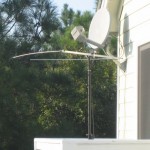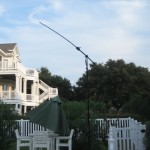Ok, I am only like two months late in writing this article, but I wanted to post some thoughts on what I did with the buddipole and Par 6 meter loop at the beach in September. They both served as very nice portable antennas. Easy to setup and configure, easy to operate and easy to take down. Here are a few of my thoughts on what I did.
First, I am going to refer you to my beach 09 photo album that shows some of what I did. As far as six meters is concerned, there was no band openings worth mentioning while I was there. On the other hand, I was able to use 6 meters to talk back to central Virginia (over 100 nautical miles). It helped that Doug was using a 9 element antenna, but I was also able to work George on 6 meters with an smaller beam that is lower. I hope that next time I am portable on 6 meters that the band is booming and I can operate from a different grid.
Onto the buddipole. First I will remind you that it does take some patience, and an antenna analyzer is a great help in getting it configured especially when you are going to run 100 watts into the antenna. I ran the antenna basically three ways.
1. typical horizontal config
2. semi-vertical (see pics)
3. NVIS configured for 80 meters
Typical horizontal configuration on 20 meters – this worked OK for single hop QSOs on 20 SSB and PSK31. Working into EU was a little tough considering the ocean was as close as it was. But if you factor in the actual height of the antenna above sea level and the take off angle, it makes sense. This was the easiest way to get on the air and see what was going on.
Semi vertical configuration – this actually worked a little better for 20 meters. Basically the antenna is actually a bit higher, and I am sure this plays a factor. It was a little more difficult to tune and required more patience to finesse the antenna to operate. I left the antenna like this for a few days. I made a bunch of QSOs back to the midwest states, and a few EU QSOs.
NVIS configured – this was my first time setting the antenna up like this, and I was a little nervous because I usually try stuff out at home before going to the field with it. It worked out just fine. Both ends of the antenna were approximately 3-4 feet off of the ground. It was easy to wind out or wind in more wire as needed on each leg to achieve resonance. There is excellent instructions on just how to setup the wire sections for 80,40 and 60 meters on the buddipole website.
Basically in this setup you can expect it to perform as a shortened dipole, since that is exactly what it is. For local and regional work on 80 meters, it worked well to communicate back to central Virginia stations. I look forward to using it again to see just how far out I can expect to work.
Ok – look at the rest of the pictures, and post any of your thoughts as well. 73.


